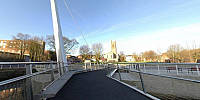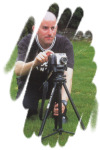© 2009 Andy Savage, All Rights Reserved.
See also the VR the Derby Cathedral Green VR tour.
Points of interest in this Panorama
This is the swing bridge at the Derby's new look, multi-million pound Cathedral Green. The project began in August 2007 and it opened to the public on March 20th, 2009, at a cost of £4.2m.This multi-million-pound facelift has new seating, paving, terracing, lighting and planting have been included in the project and the new footbridge links the Green with Stuart Street. This refurbished public space is expected to be particularly popular in the summer.
In the distance (looking at end of the swing bridge) you can see Derby Cathedral. The building became a cathedral by Royal Charter in 1927, previously it was known as All Saints' Church. The tower (64.8 metres tall) of Derby Cathedral was built 1510 to 1530. Most of the building dates from 1725. The cathedral contains the oldest ring of ten bells in the United Kingdom.
In 2005, it was discovered that several Peregrine falcons had taken up residence on the Cathedral Tower. In 2006 a nesting platform was installed and they have returned every year since. These birds have become web celebrities due to the fact that webcams were installed in 2007 so people can log on and watch their lives online. Derby Cathedral Peregrine Project with Live webcams
Derby Power station Occupied most of this site and was demolished in 1970. Today all that remains of this station is some distribution transformers which are hidden out of view by these walls. You only know they are there if you go on a Derby Cathedral Tower Open day. This allows you to look down into the walled-off area or by looking here.
On the far right of the walled area is a crane building Jurys Inn hotel on King Street. Once completed, this £25m hotel will have 226 bedrooms and be one of Derby's tallest buildings. This three-star hotel is scheduled to open in July 2009.
The Bakewell Gates These Grade II listed wrought iron gates were built in 1725 by Robert Bakewell (England's foremost wrought ironsmith) Between 1934 and 1988 these gates stood beside the library in the Wardwick. Note you can get a real close look at these decorative gates in my Virtual Tour, link below. Bakewell also produced screens for churches and screens and tables to adorn houses and public buildings throughout the midlands.
In 1706 Bakewell took up residence in Melbourne, South Derbyshire, working for Thomas Coke of Melbourne Hall, where he produced his magnificent Wrought iron arbor, sometimes called the birdcage, in Coke's gardens. It is still there today.
The Silk Mill Museum Derby's Museum of Industry and History is housed in a former Silk Mill which opened on November 29,1974. It was built on the site of the world's oldest factories, the Silk Mills built by George Sorocold in 1702 and 1717.
The foundations and parts of the tower from the 1717 mill are still visible. This mill was built to house machines for "doubling" or twisting silk into thread. John Lombe copied the design for the machines used for spinning large quantities of silk, during a period spent in Italy, working within the Italian Silk Industry. This was possibly the first example of industrial espionage. On December 5, 1910 a fire broke out in the adjacent flour mill of Sowter Bothers and soon engulfed the Silk Mill. Great efforts were made by the Borough Fire Brigade and the Midland Railway Company who saved the shell of the tower.
The building was rebuilt at the same height but with three stories instead of five and the tower placed back on top.
Derby's Museum of Industry and History.
River Derwent The Derwent rises in the Peak District at Bleaklow river and ends at Derwent Mouth (east of Shardlow), where it flows into the River Trent.
The first bridge you can see over the Derwent (upstream) is Causey Bridge which carries the Inner Ring Road, It was built in 1969. The bridge immediately behind that one is St Mary's Bridge which was built in 1794. To the left of this, on the river bank, sits the chapel of St. Mary built in 1450, one of only five remaining bridge-chapels in England.
The next building to the right is Staurt Street Apartments, built on the former Eggleston Brothers site in a £14m project.
The first bridge downstream on the River Derwent is Exeter Bridge,which opened on March 13th, 1931, by the then Minister of Transport, Herbert Morrison.
Derby's Museum of Industry and History forms part of the Derwent Valley Mills World Heritage Site which runs from the museum for 15 miles along the river Derwent to Matlock Bath's Masson Mills. www.derwentvalleymills.org/
VR Tour of Derby Cathedral green If you would like to explore the new Derby Cathedral Green area in more detail then visit my Virtual Tour of the area. This consists of several high resolution Flash based 360s which are interconnected via hotspots enabling you to wander around and have a good look at the area from many different angles.
Start the VR tour by clicking here: Derby Cathedral Green VR tour.
Even More information Maps: Google Streetview captured the lorry delivering the mechanical control mechanism for the bridge when they were parked up.
Birds eye view of this area (taken before the Cathedral Green was revamped).
Some of my other Panoramas of Derwent Valley Mills World Heritage Sites
Leawood Pumping Station
Masson Mills Textile Museum
Photographs Photographs of the Industrial Museum & Full Street areas of Derby.



 Tap or click the zoom icon in the bottom right corner of the picture to switch between in-page and fullscreen view
Tap or click the zoom icon in the bottom right corner of the picture to switch between in-page and fullscreen view